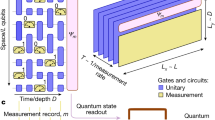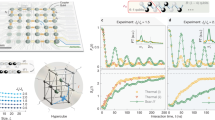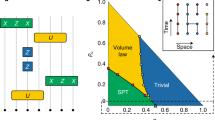Abstract
Quantum many-body systems subjected to unitary evolution with the addition of interspersed measurements exhibit a variety of dynamical phases that do not occur under pure unitary evolution. However, these systems remain challenging to investigate on near-term quantum hardware owing to the need for numerous ancilla qubits or repeated high-fidelity mid-circuit measurements, a capability that has only recently become available. Here we report the realization of a measurement-induced entanglement phase transition with a hybrid random circuit on up to 14 superconducting qubits with mid-circuit readout capability. We directly observe extensive and sub-extensive scaling of entanglement entropy in the volume- and area-law phases, respectively, by varying the rate of the measurements. We also demonstrate phenomenological critical behaviour by performing a data collapse of the measured entanglement entropy. Our work establishes the use of mid-circuit measurement as a powerful resource for quantum simulation on near-term quantum computers.
This is a preview of subscription content, access via your institution
Access options
Access Nature and 54 other Nature Portfolio journals
Get Nature+, our best-value online-access subscription
$29.99 / 30 days
cancel any time
Subscribe to this journal
Receive 12 print issues and online access
$209.00 per year
only $17.42 per issue
Buy this article
- Purchase on Springer Link
- Instant access to full article PDF
Prices may be subject to local taxes which are calculated during checkout




Similar content being viewed by others
Data availability
Data that support the findings of this study are publicly available via the Open Science Framework at https://osf.io/wkx49/.
Code availability
Code used in this study is publicly available via the Open Science Framework at https://osf.io/wkx49/.
References
Calabrese, P. & Cardy, J. Evolution of entanglement entropy in one-dimensional systems. J. Stat. Mech. Theory Exp. 2005, P04010 (2005).
Kim, H. & Huse, D. A. Ballistic spreading of entanglement in a diffusive nonintegrable system. Phys. Rev. Lett. 111, 127205 (2013).
Liu, H. & Suh, S. J. Entanglement tsunami: universal scaling in holographic thermalization. Phys. Rev. Lett. 112, 011601 (2014).
Kaufman, A. M. et al. Quantum thermalization through entanglement in an isolated many-body system. Science 353, 794–800 (2016).
Nahum, A., Ruhman, J., Vijay, S. & Haah, J. Quantum entanglement growth under random unitary dynamics. Phys. Rev. X 7, 031016 (2017).
von Keyserlingk, C. W., Rakovszky, T., Pollmann, F. & Sondhi, S. L. Operator hydrodynamics, OTOCs, and entanglement growth in systems without conservation laws. Phys. Rev. X 8, 021013 (2018).
Davies, E. B. & Davies, E. Quantum Theory of Open Systems (Academic, 1976).
Misra, B. & Sudarshan, E. C. G. The Zeno’s paradox in quantum theory. J. Math. Phys. 18, 756–763 (1977).
Wheeler, J. & Zurek, W. Quantum Theory and Measurement (Princeton Univ. Press, 1983).
Zhu, X. et al. Quantum measurements with preselection and postselection. Phys. Rev. A 84, 052111 (2011).
Elliott, T. J., Kozlowski, W., Caballero-Benitez, S. F. & Mekhov, I. B. Multipartite entangled spatial modes of ultracold atoms generated and controlled by quantum measurement. Phys. Rev. Lett. 114, 113604 (2015).
Dhar, S. & Dasgupta, S. Measurement-induced phase transition in a quantum spin system. Phys. Rev. A 93, 050103 (2016).
Mazzucchi, G., Kozlowski, W., Caballero-Benitez, S. F., Elliott, T. J. & Mekhov, I. B. Quantum measurement-induced dynamics of many-body ultracold bosonic and fermionic systems in optical lattices. Phys. Rev. A 93, 023632 (2016).
Li, Y., Chen, X. & Fisher, M. P. A. Quantum Zeno effect and the many-body entanglement transition. Phys. Rev. B 98, 205136 (2018).
Chan, A., Nandkishore, R. M., Pretko, M. & Smith, G. Unitary-projective entanglement dynamics. Phys. Rev. B 99, 224307 (2019).
Li, Y., Chen, X. & Fisher, M. P. Measurement-driven entanglement transition in hybrid quantum circuits. Phys. Rev. B 100, 134306 (2019).
Skinner, B., Ruhman, J. & Nahum, A. Measurement-induced phase transitions in the dynamics of entanglement. Phys. Rev. X 9, 031009 (2019).
Szyniszewski, M., Romito, A. & Schomerus, H. Entanglement transition from variable-strength weak measurements. Phys. Rev. B 100, 064204 (2019).
Zabalo, A. et al. Critical properties of the measurement-induced transition in random quantum circuits. Phys. Rev. B 101, 060301 (2020).
Nahum, A., Roy, S., Skinner, B. & Ruhman, J. Measurement and entanglement phase transitions in all-to-all quantum circuits, on quantum trees, and in Landau-Ginsburg theory. PRX Quantum 2, 010352 (2021).
Gebhart, V. et al. Topological transition in measurement-induced geometric phases. Proc. Natl Acad. Sci. USA 117, 5706–5713 (2020).
Zilberberg, O. et al. Null values and quantum state discrimination. Phys. Rev. Lett. 110, 170405 (2013).
Wiseman, H. M. Quantum trajectories and quantum measurement theory. J. Eur. Opt. Soc. Pt B 8, 205–222 (1996).
Lunt, O., Szyniszewski, M. & Pal, A. Measurement-induced criticality and entanglement clusters: a study of one-dimensional and two-dimensional Clifford circuits. Phys. Rev. B 104, 155111 (2021).
Turkeshi, X., Fazio, R. & Dalmonte, M. Measurement-induced criticality in (2 + 1)-dimensional hybrid quantum circuits. Phys. Rev. B 102, 014315 (2020).
Yu, X. & Qi, X.-L. Measurement-induced entanglement phase transition in random bilocal circuits. Preprint at https://arxiv.org/abs/2201.12704 (2022).
Tang, Q. & Zhu, W. Measurement-induced phase transition: a case study in the nonintegrable model by density-matrix renormalization group calculations. Phys. Rev. Res. 2, 013022 (2020).
Turkeshi, X., Biella, A., Fazio, R., Dalmonte, M. & Schiró, M. Measurement-induced entanglement transitions in the quantum Ising chain: from infinite to zero clicks. Phys. Rev. B 103, 224210 (2021).
Lavasani, A., Alavirad, Y. & Barkeshli, M. Measurement-induced topological entanglement transitions in symmetric random quantum circuits. Nat. Phys. 17, 342–347 (2021).
Choi, S., Bao, Y., Qi, X.-L. & Altman, E. Quantum error correction in scrambling dynamics and measurement-induced phase transition. Phys. Rev. Lett. 125, 030505 (2020).
Li, Y. & Fisher, M. P. A. Statistical mechanics of quantum error correcting codes. Phys. Rev. B 103, 104306 (2021).
Fan, R., Vijay, S., Vishwanath, A. & You, Y.-Z. Self-organized error correction in random unitary circuits with measurement. Phys. Rev. B 103, 174309 (2021).
Vasseur, R., Potter, A. C., You, Y.-Z. & Ludwig, A. W. W. Entanglement transitions from holographic random tensor networks. Phys. Rev. B 100, 134203 (2019).
Bao, Y., Choi, S. & Altman, E. Theory of the phase transition in random unitary circuits with measurements. Phys. Rev. B 101, 104301 (2020).
Jian, C.-M., You, Y.-Z., Vasseur, R. & Ludwig, A. W. W. Measurement-induced criticality in random quantum circuits. Phys. Rev. B 101, 104302 (2020).
Sang, S. et al. Entanglement negativity at measurement-induced criticality. PRX Quantum 2, 030313 (2021).
Block, M., Bao, Y., Choi, S., Altman, E. & Yao, N. Y. Measurement-induced transition in long-range interacting quantum circuits. Phys. Rev. Lett. 128, 010604 (2022).
Gullans, M. J. & Huse, D. A. Dynamical purification phase transition induced by quantum measurements. Phys. Rev. X 10, 041020 (2020).
Noel, C. et al. Measurement-induced quantum phases realized in a trapped-ion quantum computer. Nat. Phys. 18, 760–764 (2022).
Córcoles, A. D. et al. Exploiting dynamic quantum circuits in a quantum algorithm with superconducting qubits. Phys. Rev. Lett. 127, 100501 (2021).
Rost, B. et al. Demonstrating robust simulation of driven-dissipative problems on near-term quantum computers. Preprint at https://arxiv.org/abs/2108.01183 (2021).
Jurcevic, P. et al. Demonstration of quantum volume 64 on a superconducting quantum computing system. Quantum Sci. Technol. 6, 025020 (2021).
Kandala, A. et al. Hardware-efficient variational quantum eigensolver for small molecules and quantum magnets. Nature 549, 242–246 (2017).
Li, Y., Chen, X., Ludwig, A. W. W. & Fisher, M. P. A. Conformal invariance and quantum nonlocality in critical hybrid circuits. Phys. Rev. B 104, 104305 (2021).
Fisher, M. E. & Barber, M. N. Scaling theory for finite-size effects in the critical region. Phys. Rev. Lett. 28, 1516 (1972).
Binder, K. & Heermann, D. W. Monte Carlo Simulation in Statistical Physics 5th edn (Springer, 2010).
Gullans, M. J. & Huse, D. A. Scalable probes of measurement-induced criticality. Phys. Rev. Lett. 125, 070606 (2020).
Li, Y., Zou, Y., Glorioso, P., Altman, E. & Fisher, M. Cross entropy benchmark for measurement-induced phase transitions. Preprint at https://arxiv.org/abs/2209.00609 (2022).
Lee, J. Y., Ji, W., Bi, Z. & Fisher, M. Decoding measurement-prepared quantum phases and transitions: from Ising model to gauge theory, and beyond. Preprint at https://arxiv.org/abs/2208.11699 (2022).
Sang, S. & Hsieh, T. H. Measurement-protected quantum phases. Phys. Rev. Res. 3, 023200 (2021).
Tantivasadakarn, N., Thorngren, R., Vishwanath, A. & Verresen, R. Long-range entanglement from measuring symmetry-protected topological phases. Preprint at https://arxiv.org/abs/2112.01519 (2021).
Tantivasadakarn, N., Verresen, R. & Vishwanath, A. The shortest route to non-Abelian topological order on a quantum processor. Preprint at https://arxiv.org/abs/2209.03964 (2022).
Tantivasadakarn, N., Vishwanath, A. & Verresen, R. A hierarchy of topological order from finite-depth unitaries, measurement and feedforward. Preprint at https://arxiv.org/abs/2209.06202 (2022).
Nielsen, E. et al. Gate set tomography. Quantum 5, 557 (2021).
de Burgh, M. D., Langford, N. K., Doherty, A. C. & Gilchrist, A. Choice of measurement sets in qubit tomography. Phys. Rev. A 78, 052122 (2008).
Aleksandrowicz, G. et al. Qiskit: an open-source framework for quantum computing. Zenodo https://zenodo.org/record/2562111 (2019).
Smolin, J. A., Gambetta, J. M. & Smith, G. Efficient method for computing the maximum-likelihood quantum state from measurements with additive Gaussian noise. Phys. Rev. Lett. 108, 070502 (2012).
Hamamura, I. & Imamichi, T. Efficient evaluation of quantum observables using entangled measurements. npj Quantum Inf. 6, 56 (2020).
Yen, T.-C., Verteletskyi, V. & Izmaylov, A. F. Measuring all compatible operators in one series of single-qubit measurements using unitary transformations. J. Chem. Theory Comput. 16, 2400–2409 (2020).
Durt, T., Englert, B.-G., Bengtsson, I. & Życzkowski, K. On mutually unbiased bases. Int. J. Quantum Inf. 8, 535–640 (2010).
Romero, J. L., Björk, G., Klimov, A. B. & Sánchez-Soto, L. L. Structure of the sets of mutually unbiased bases for n qubits. Phys. Rev. A 72, 062310 (2005).
Gokhale, P. et al. Minimizing state preparations in variational quantum eigensolver by partitioning into commuting families. Preprint at https://arxiv.org/abs/1907.13623 (2019).
Serra, P. & Kais, S. Data collapse for the Schrödinger equation. Chem. Phys. Lett. 319, 273–277 (2000).
Bhattacharjee, S. M. & Seno, F. A measure of data collapse for scaling. J. Phys. A 34, 6375–6380 (2001).
Acknowledgements
S.S. and A.J.M. were supported by the US Department of Energy under award no. DE-SC0019374. M.M. acknowledges J. Burks, D. McClure, S. Sheldon and M. Stypulkoski for help with access to, and use of, IBM Quantum devices. M.M. also acknowledges helpful discussions with L. Govia, E. Chen, and A. Kandala. The authors acknowledge the use of IBM Quantum services for this work.
Author information
Authors and Affiliations
Contributions
J.M.K., S.-N.S. and A.J.M. conceived and initiated the project. A.J.M. supervised the project. J.M.K. developed the quantum simulation codebase and ran experiments on emulators and quantum hardware. M.M. contributed to the codebase and ran experiments on quantum hardware. All authors contributed to the discussion of results and writing of the paper.
Corresponding author
Ethics declarations
Competing interests
The authors declare no competing interests.
Peer review
Peer review information
Nature Physics thanks Daniel Sank and the other, anonymous, reviewer(s) for their contribution to the peer review of this work.
Additional information
Publisher’s note Springer Nature remains neutral with regard to jurisdictional claims in published maps and institutional affiliations.
Supplementary information
Supplementary Information
Supplementary Notes 1–7, Figs. 1–11 and Tables 1–3.
Rights and permissions
Springer Nature or its licensor (e.g. a society or other partner) holds exclusive rights to this article under a publishing agreement with the author(s) or other rightsholder(s); author self-archiving of the accepted manuscript version of this article is solely governed by the terms of such publishing agreement and applicable law.
About this article
Cite this article
Koh, J.M., Sun, SN., Motta, M. et al. Measurement-induced entanglement phase transition on a superconducting quantum processor with mid-circuit readout. Nat. Phys. 19, 1314–1319 (2023). https://doi.org/10.1038/s41567-023-02076-6
Received:
Accepted:
Published:
Issue Date:
DOI: https://doi.org/10.1038/s41567-023-02076-6
This article is cited by
-
Quantum hardware measures up to the challenge
Nature Physics (2023)
-
Measurement-induced entanglement and teleportation on a noisy quantum processor
Nature (2023)



